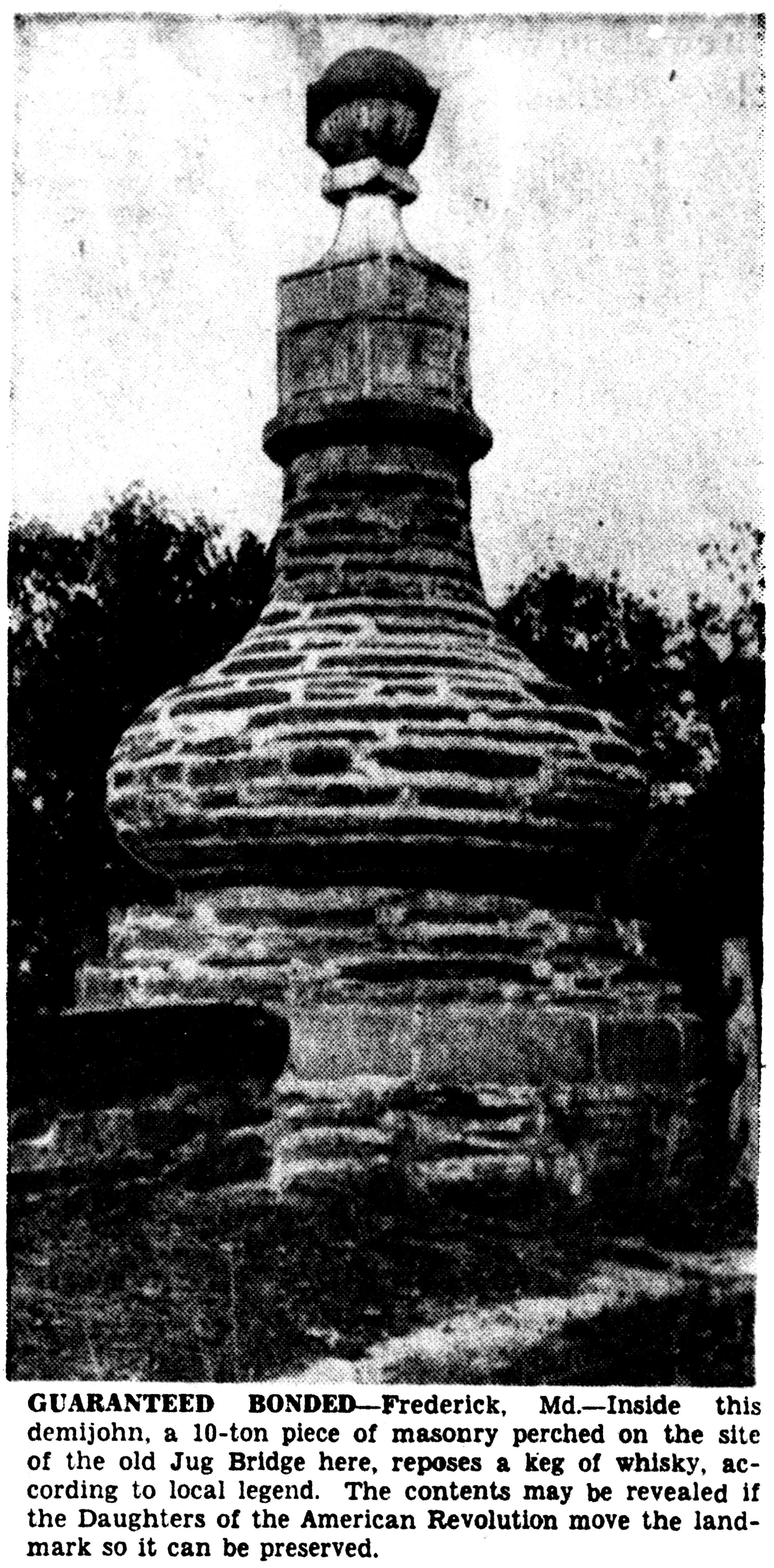DARs Dip Into the Past, Rally to Historic Keg
By Smith Hempstone, Star Staff Correspondent

FREDERICK, Md., Dec. 21.
Members of the Frederick chapter of the DAR, of all people, may be on the verge of uncorking the oldest keg of whisky around these parts.
It all started with Leo Harbaugh. He was a stonemason and a pretty good country engineer up Frederick way in the early 1800's. Thomas Jefferson was in the White House at the time, had just completed the Louisiana Purchase, and found the real estate business rather slow after that, so he decided to go into the road - building business: Something that would run from the Baltimore-Washington area up through Frederick to Cumberland and out to the West.
Leo, who Frederick folks say did most of the masonry on the White House, was his man.
Bridge the Monocacy
He was given the job of building a bridge across the Monocacy River three miles east of Frederick.
The job was started in 1808 and finished the following year. And quite a job it was, too: four stone arches, each 65 feet long.
When the bridge was finished, Leo, who wasn't the bashful type, wanted to make sure that nobody forgot who did the job.
At the eastern end of the bridge he built a huge masonry demijohn, better than 10 feet, tall, inscribed his own name on it along with those of some of the other fellows on the job and, so legend has it, sealed a keg of whisky inside the monument.
Now some folks might regard that bit of cornerstone-filling in poor taste. But Leo knew his Frederick.
According to the official “History of Frederick County” written by T. J. C. Williams and Folger McKinsy, “the Bentztown Bard,” Frederick at the time the bridge was built had a population of 1,236 males. 1,244 females—and 140 distilleries.
100 Gallons a Year
These distilleries produced 145,000 gallons of whisky a year which means every manjack in the town could swill better than 100 gallons a year providing he kept the womenfolks on the wagon and didn't have any need for hard cash.
So you can see that both the demijohn monument and the keg of whisky inside, if it’s there, were quite appropriate.
Leo was fat and happy until three days later one of the arches began to flatten out. He figured that his bridge shortly would be in the Moncacy, so the legend goes, he hot-footed it out of Frederick for parts unknown.
It did fall in the Monocacy, —134 years later.
Nothing untoward happened for quite some time.
In 1824, Lafayette dropped in at Frederick and made a speech at the bridge, but nobody knows what he said.
The next we hear of Frederick is in September, 1862, when Robert E. Lee is out with Stonewall Jackson on one of their periodic strolls through Maryland.
Whittier's Word for It
An old lady by the name of Barbara Frietchie got into a hassle with Jackson and soon put him in his place—if we are to believe John Greenleaf Whittier, who wasn't there either.
Whittier doesn't mention the demijohn or the whisky inside, and Jackson's troops, being servicemen, certainly would have taken care of that in short order if they’d known about it.
Two years later Jubal Early dropped around, crossed Leo's bridge and, in preference to having to listen to Barbara Frietchie sound off, defeated Lew Wallace in the battle of the Monocacy and marched on Washington. He got as far as Mount St. Alban before Grant changed his mind for him. He burned Chambersburg, Pa., instead.
On March, 3, 1942, Leo's bridge, finally suffered a severe case of fallen arches—into the Monocacy. This conclusively ended the long-standing argument as to whether it was safe.
A new bridge across the Monocacy was completed two years later several hundred yards from the old one. Leo's demijohn, neglected and out of sight of passing motorists, began to deteriorate.
Target of Small Boys
Small boys used it as a target to demonstrate their rock-throwing ability and more than one thirsty Fredericktonian tried to break open the demijohn.
When it was announced that another Monacacy bridge would be built close to the old one to make Route 240 dual lane, the DAR ladies swung into action.
Frederick Regent Mrs. Paul B. Rhoads informed the State Roads Commission that the demijohn should be moved to a suitable point between the two bridges.
The State roads people said maybe but the ladies might have to pay for having the demijohn moved.
Mrs. Rhoads said that might be, but the demijohn was going to its proper place. State officials said they would see what they could do.
And that's where the matter rests.
Joseph W, Urner, president of the Historical Society of Frederick County, estimates that the demijohn weighs at least 10 tons.
“The best thing to do,” he adds with a smile, “might be to dismantle the demijohn and rebuild it again. … 145 years old … that keg should have real authority by now.”